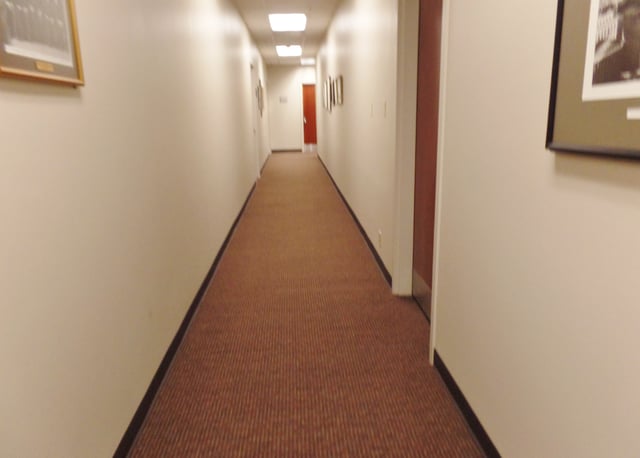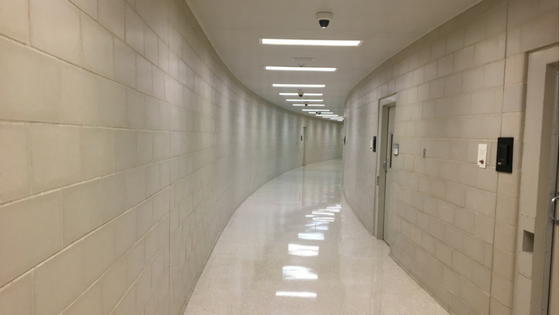As a court planning consultant, I often find myself sitting across from court managers and law enforcement officials who are facing a challenge – how to address prisoner movement in an existing courthouse that contains no dedicated secure circulation. If there is excess space in the courthouse and a healthy funding source for improvements, of course we can all come up with solutions. For example, dedicated secure corridors could be designed and a prisoner elevator might be provided. But most of the time, the building has no available expansion space and courts are on a shoestring budget. Perhaps you have found yourself trying to come up with a way to address this issue in your courthouse.
No Easy Answers for Courthouse Security
In situations such as this, we have a major challenge. Maybe even an ethical dilemma. How can secure prisoner circulation be provided without secure elevators and corridors dedicated solely to prisoner movement? There are really only two options – move prisoners through the restricted judges’ corridor (if there is one), or move them through the public corridors. Obviously, neither of these solutions is very good, thus my ethical dilemma. But is one solution better than the other? This is when I find myself trying to make the best of a bad situation. To tell you the truth, it’s kind of uncomfortable for me that I can’t just give an easy answer.
Where to Start?
When trying to decide on the best route for prisoner movement, I try to find existing circulation paths – both vertically and horizontally – that can serve a dual purpose. Because courtrooms are usually located on upper floors, the first thing I look for is a freight elevator. Freight elevators are used infrequently and usually link up with corridors that are somewhat separated from the main building circulation. Law enforcement personnel will tell you this is most important when moving prisoners.
In the absence of a freight elevator, a dedicated judges’ elevator is sometimes the next best option. A judges’ elevator has a limited number of authorized users and, like the freight elevator, it is usually connected to a series of restricted corridors that are separate from the main corridors. (I have also seen freight elevators serving a dual purpose as a freight/judges’ elevator in many courthouses.)
Whether using a freight elevator or judges’ elevator, access controls should be installed to prevent others from using the elevator when it is being used for prisoner movement. This might seem obvious, but more than once I have called the freight elevator while assessing a courthouse only to come face to face with law enforcement personnel scrambling to close the door because they were moving a shackled prisoner. Believe me, when I saw them I quickly changed my mind about climbing aboard! But think about it… if a judge called the elevator and it opened to that scene, it could get pretty dicey – particularly if the prisoner recognized the judge!
Using a physical key at the elevator control panel is the typical way to limit the use of an elevator. However, many courthouses limit access by utilizing a card key access control system. If the elevator is used to move prisoners, the card key system could be tapped to restrict access during those periods. I would suggest that for more secure access control, a scramble pad should be installed in the elevator so that law enforcement personnel would not need to have a special key or card that could be lost or stolen.
I believe strongly that the last resort for vertical prisoner movement is the public elevator. If there is no choice but to use the public elevator to transport prisoners, the same lockout mechanisms should be installed. Whatever the solution, if the elevator is in use for prisoner movement it should override normal elevator operations and bypass any stop-request that is not initiated by those moving the prisoner. Once the prisoner is unloaded, the elevator would return to normal use.
Decision Time - How to Get From Here to There
When it’s time for decisions to be made about how best to accommodate prisoner circulation without a secure corridor, I try to direct the court planning team to consider what is best for their particular situation. This often leads to considering the corridors that the judges’ or public elevator exits into. Most likely, if the public elevator were used it would exit into a public corridor. On the other hand, the judges’ elevator or combined freight/judges’ elevator) would likely exit into a restricted judges’ corridor. Which is better – using a restricted judges’ corridor or the public corridor? Is it more important to keep prisoners away from the public or away from the judges? It’s an intriguing question, and one that’s difficult to answer.
Judges’ Corridor
Let’s take a look at the judges’ corridor first. One thing about this circulation path is that is usually ends up at a courtroom – the prisoner’s ultimate destination. Consider this a big “pro” for the judges’ corridor option. Another big advantage is that there is usually a limited amount of foot traffic in a judges’ corridor. The challenge is to keep it that way while moving the prisoner through. Other than having deputies stand guard at every door into the corridor, this can only be done through electronic means.
 Narrow Judges’/Prisoner Corridor
Narrow Judges’/Prisoner Corridor
Depending upon the layout of the circulation path to the courtroom, there might be opportunities to install doors that would automatically close to section off a portion of the corridor for prisoner movement. This is called an interlock corridor. The doors would remain locked while the prisoner is moved through that area. To prevent someone from opening a door into the corridor from an adjacent room while prisoners are being moved, a signal light is installed on doors that open into the corridor to indicate prisoner movement. The doors could also be electronically locked when the interlock corridor is in use. I have seen this done mostly for doors to/from judges’ chambers, but it could be accomplished for just about any door. The corridor would likely already be covered by camera surveillance, but if not, a camera should be installed in this section of the corridor.
One of the biggest drawbacks to utilizing a restricted judges’ corridor is that it is typically a narrow corridor – a point brought up quickly by law enforcement personnel. Moving a prisoner typically involves at least two deputies escorting a prisoner in restraints. That’s a lot of bodies moving along in a rather tight space. Anything could happen, and the prisoner could attempt to injure a deputy and break free. If such an incident were to occur, at least the corridor is in a restricted area away from public exits.
Public Corridor
While the judges’ corridor seems to be a workable option for prisoner movement, sometimes the public corridor is the better – or only – option. Many times, in small one- or two-courtroom courthouses, I find that the public elevator is the only option, as there simply is no judges’ elevator. Plus, public corridors are typically wide, giving the deputies some space between themselves and the prisoner.
 Public Corridor Encounter
Public Corridor Encounter
However, I am not a big fan of using public corridors if it can be helped, for several reasons. First, it is typically the most heavily traveled route in the courthouse and leads to the courtroom’s public entrance – making a spectacle of the prisoner being escorted to the courtroom. Imagine being the child of that prisoner, waiting outside the courtroom and seeing them paraded in by law enforcement. That would certainly be a jarring memory, no matter the outcome of the trial. Or what if someone wanted to harm the prisoner? They could easily wait in the public corridor until they were able to attack the prisoner passing by. This would clearly put many people at risk. Camera coverage and securing doors along the circulation path would also be a challenge, as the route might be circuitous and involve passing by several different building tenants. When using the public corridors, I also try to point out that if a prisoner were to break free from the deputies they could reach the public exits, creating an even more dangerous situation.
Let the Debate Begin
When you look closely at the possibilities for moving prisoners through a courthouse with no secure circulation, it essentially comes down to making the best out of what is inherently a bad situation. In general, I tend to prefer using the judges’ elevator and corridor when possible to minimize the risks. However, in the examples above, I have only scratched the surface of the advantages and disadvantages of moving prisoners in these situations. Obviously, much depends on the layout of the courthouse and the location of the courtrooms. On more than one occasion, I have even suggested that the best route is a combination of the two!
Regardless of the solution, maintaining a safe environment for all courthouse users, including the prisoner, must be the top priority. After all, no one wants to encounter a potentially dangerous situation, or come face to face with escorted prisoners as I have done. I think we can all agree any drama should be left in the courtroom!
____________________________________________
Learn more about courthouse security in our Courtroom and Chambers Design eBook







.jpg)
.jpg)
.jpg)
.jpg)
.jpg)
.jpg)


.jpg)
.jpg)
-1.jpg)
.jpg)
.jpg)
.jpg)
.jpg)
.jpg)

